One of the biggest and most important holidays for Christians is Easter. It embodies not only the rebirth and the beginning of a new life, but also the spring and the awakening of nature from winter hibernation. An integral sacral attribute of Easter are eggs, which are often covered with skilful patterns and images. There are different techniques and varieties of painting eggs for Easter. Let's take a closer look at each of them.
Techniques for painting Easter eggs
Easter eggs symbolize the rebirth and creation of a new life. They are covered with special sacral signs, in order to attract prosperity to their home for the next year.
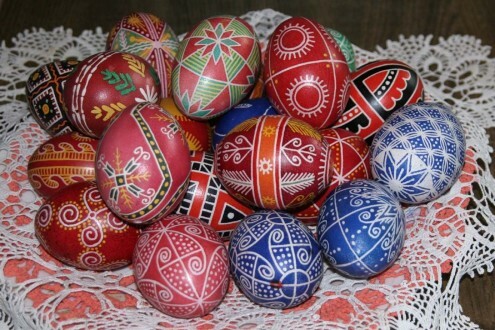
Earlier, Easter eggs were associated with many different rituals, most of which to date have been completely forgotten. For example, young girls took skilfully painted with certain symbols and images of eggs, danced around the fire, and then beat them about each other in the dance. Then they were buried in the ground, thereby attracting the goddess of fertility.
For today it is customary to distinguish the following techniques of painting Easter eggs:
- Punctuated painting. It is carried out with the help of a poke( cotton wool) and acrylic paints. A pin is applied perpendicularly to the surface of the egg and a pattern is applied. As a rule, various plant ornaments create this technique. To fix the result and give the finished work an attractive shine, the egg is covered with a special varnish( you can use a varnish for furniture).
- Drawing
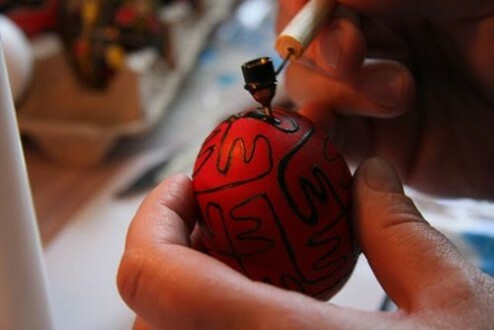 pattern and patterns with hot wax and dye. Painting is done with a special tool - pencil, which has a sharp metal tip. With the help of this technique, you can create with your own hands the real masterpieces of art painting.
pattern and patterns with hot wax and dye. Painting is done with a special tool - pencil, which has a sharp metal tip. With the help of this technique, you can create with your own hands the real masterpieces of art painting. - Engraving - drawing on the surface of the Easter egg is created during its scratching with the help of any sharp tool. Pre-egg color in any color. To create a beautiful ornament, you can also use a stencil. With the help of the presented technique, a painting of Easter eggs is created.
- Painting by brush and paints. In addition, you can decorate the surface of Easter eggs with conventional markers, gel pens and liners.
The value of sacred symbols in the
murals Traditionally, various sacral symbols and images of animals are used in the painting of Easter eggs. Each of them has a certain meaning.
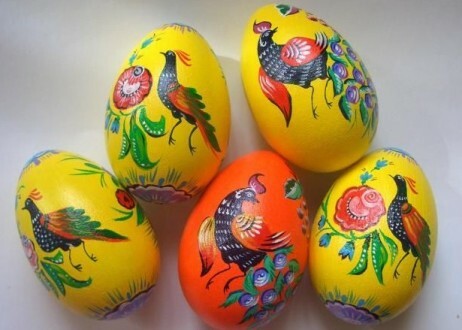

Let's look at the values of the symbols most used in the mural:
- The vine is a symbolic representation of Jesus Christ.
- The cross is a symbol of the Universe and the Universe. In addition, it symbolizes the four sides of the world, four seasons and four wind directions.
- The star is a symbol that basically answers during the time: during birth, death, grace, during the year, etc.
- The pigeon is a symbol of the soul and fidelity.
- Setochka symbolizes human destiny.
- A rhombus( square) symbolizes material prosperity and well-being. In addition, he is the personification of the feminine.
- Hop symbolizes fertility.
- An image of a woman standing with arms raised to the sky is the symbol of Bereginya, who is the keeper of the home.
- Flowers
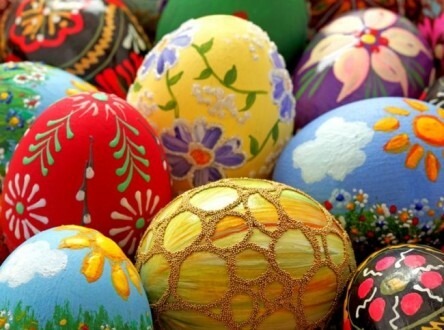 - a symbol of purity, beauty and girlhood.
- a symbol of purity, beauty and girlhood. - Berries symbolize motherhood and fertility.
- Buckles symbolize the rain.
- The sun is the symbol of God the Creator.
- Spiral is a symbol of fertility and inexorable flow of time.
- Birds symbolize the birth of a new life. They are also messengers of spring.
- Oak leaf is the personification of a strong masculine.
- A rooster is a harbinger of a new day, a guardian of good and a defender of the forces of evil.
- Grapes are a symbol of the genus.
- Fish is a symbol of water, health and life.
Quite often, besides patterns and images on Easter eggs, the inscriptions: "Christ is Risen!" Or simply "HB".
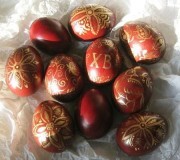
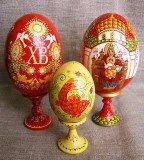
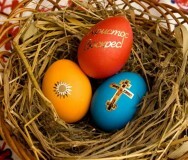
How can I paint eggs for Easter?
Today there are 4 main types of Easter eggs. Among them:
- Pysanka - one of the most complicated paintings, carried out with the help of hot wax.
- Krashanka - coloring the eggs in one color.
- Drapanka - applying the pattern by scratching it on the pre-painted surface of the egg.
- Krapanka - painting, as well as for pysanka, is carried out with the help of paint and hot wax. However, in this case, wax is closed by those places that are not subject to staining.
 Pisanka
Pisanka 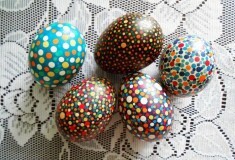 Krapanka
Krapanka 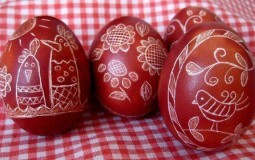 Drapanka
Drapanka  Kashanka
Kashanka In addition, there are many other varieties of painted Easter eggs. Let's consider the most interesting of them:
- Vegetable ornaments. Easter eggs are dipped in a natural color. In this case, they are attached to them with leaves of various plants or flowers, and then put on gauze. As a result, after painting, a beautiful plant pattern remains on the surface of the shell. Traditionally, eggs were cooked in onion husk, to obtain a golden brown color. Such eggs turned out not only beautiful, but also useful.
- Malevanki - painting with various patterns and patterns that do not have sacred significance. For example, often enough they depict nature or various plot scenes.
- Slagens - painting is done with the help of straw.
-
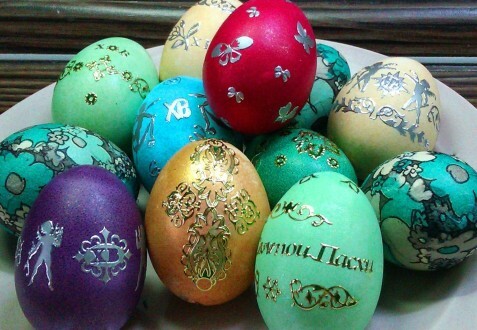 stickers are Easter eggs with pasted on their surface images or patterns. Similar stickers can be purchased in finished form in stores or on the market.
stickers are Easter eggs with pasted on their surface images or patterns. Similar stickers can be purchased in finished form in stores or on the market. - Create a pattern with a thin mesh, which is braided over the surface of the eggs.
- Easter painting with colored wax. Unlike pysanki and krapanka, the wax remains on the eggshell. Such figures are obtained in relief and color.
- Embroideries - embroider cross designs on fabrics, which then cover the surface of Easter eggs.
- Openwork Easter patterns - creating a delicate openwork pattern with the help of a drill.
- Beaded patterns - on artificial or natural Easter eggs, a small bead is glued to the shell. With the help of beads of various colors, you can create beautiful drawings and ornaments.
Pisanka: features and technique of performing
The oldest tradition of the ritual painting is a pysanka. It is a drawing with the help of hot wax, paints and a special tool of sacred in its meaning patterns and images.
Technique for painting the pysanka has the following sequence:
- Egg is well washed in warm slightly salted water, and then for about 30 seconds soaked in a weak aqueous solution of vinegar. This allows you to clean it from pollution and negative energy.
- Using a steel tip, a pattern is applied to the surface of the shell with hot wax, and then it is dipped into a diluted cold paint. Please note that the application of paints starts from the lightest shade.
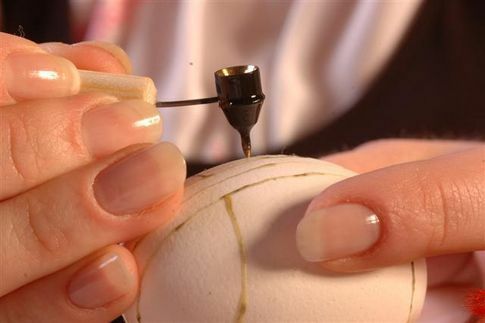
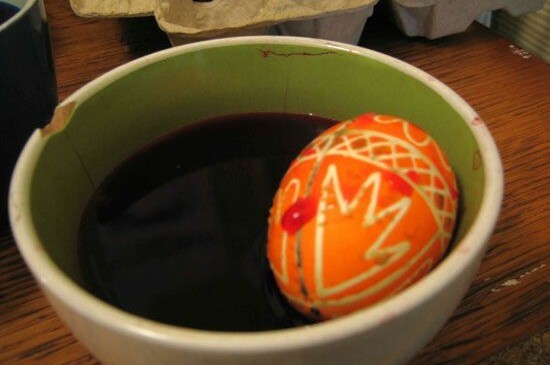
- After applying the paint, the shell is wiped with a special piece of cloth, and then proceeds to the next part of the pattern and a new shade of the coloring material is applied.
- After the pattern has been completely applied to the surface of the shell, the wax is gently strewed from its surface by means of a candle flame, a preheated oven, an oven, etc.
- The melted wax is removed using a piece of cloth or paper.
Typically, a similar painting is applied to a raw chicken egg. Interesting schemes of painting Easter eggs you can find on the Internet on specialized sites.
Slavic pysanka: how to beautifully paint an egg - video
Kashanka: features of the
execution This is the easiest and quickest way to decorate Easter eggs. Most often they are painted in red, which is a symbol of love, eternal life, solar heat, fertility and beauty. Staining is carried out with the help of special paints or natural dyes.
Natural paints consist entirely of natural ingredients and do not contain any harmful chemical elements. In addition, they do not spread and are not smeared during the application of a pattern or pattern to the surface of the shell, which can not be said for artificial dyes.
Let's look at how you can get a certain color with natural dyes:
- Red. To obtain a beautiful and rich color, you can use pomegranate or cherry juice. Also, to obtain a red color, you can use the infusion of St. John's wort.
- Pink.
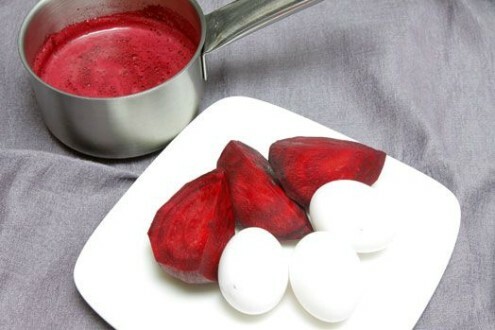 Get a saturated shade of beetroot or grapefruit juice.
Get a saturated shade of beetroot or grapefruit juice. - Green. You can get a natural shade with the help of juice made from spinach leaves.
- Golden brown. Get this shade allows decoction of dill seeds.
- Yellow. A saturated sunny-yellow shade is obtained from decoction of lemon or orange peels, and also with the help of turmeric or decoction of the crust of wild apple trees.
- Orange. A similar shade gives red ground pepper.
- Purple. The presented shade is obtained from the decoction of purification of red onions.
- Brown.
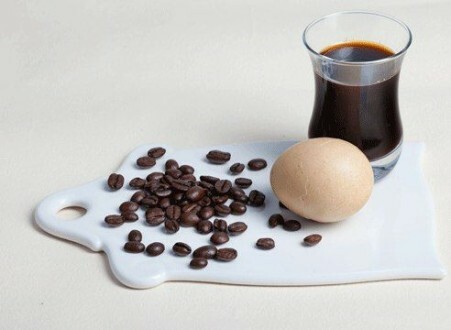 A beautiful brown shade can be achieved by using strong tea or coffee.
A beautiful brown shade can be achieved by using strong tea or coffee. - Blue can be obtained by using canned blueberries or by making a decoction from the leaves of red cabbage.
Please note that natural dyes, unlike artificial dyes, have a lower degree of durability. Over time, their color becomes duller, and then almost completely disappears. Therefore, these dyes are used exclusively for natural eggs, which are intended for the festive Easter table.
Drapanka: features and technique of performing
This is one of the varieties of Easter decoration, which is decorated with natural or artificial Easter eggs. Drawing and patterns are applied using engraving techniques. With proper skill, they are beautiful and neat.
The technology of draping is interesting primarily because it does not require special tools and a set of paints. For her, you can choose an egg of dark color and tint it with a darker dye( natural or artificial).The ornament is applied with a simple pencil, and then it is scratched on the surface of the shell with the help of a conventional sewing needle, a knife or an awl.

You can use a goose, chicken or duck egg to make drapanka. The strongest are goose. Therefore, they are often given preference for engraving techniques.
Before staining a fresh egg is well washed in warm water with the addition of a small amount of usual kitchen salt. Then wipe it with a soft cloth and blow out the contents.
To blow out the contents, it is necessary to make 2 holes in the shell from opposite sides. The diameter of the hole is about 3 mm. Then, holding the egg over the glass, blow into one of its holes, as a result, through the other, its contents flow out. Before painting, the holes are well covered with paraffin or wax, so that the paint does not get inside.
Decor of eggs in the technique of drapery - video
Caps: features and techniques of performing
When compared with pysanki, the technique of making flaps is simple enough, although it is performed with hot wax and pencil with a sharp metal tip. To make the flaps, the following procedure should be followed:
- Raw egg is washed and dried.
- The beeswax is melted in a water bath. It should become liquid, but in no case should it boil.
- Apply
 with a piss of hot wax exclusively to those places that paint should not get to.
with a piss of hot wax exclusively to those places that paint should not get to. - Then the egg is dipped in the coloring material. Apply the paint starting from the lightest shade, gradually turning to the darkest.
- At the end of the Easter egg put in the oven or in a mildly melted oven. It is necessary that the wax softens and it is easy to remove from the surface of the shell with a soft cloth.
- After the ink has dried, the surface of the shell can be covered with wax droplets.
Some interesting ideas how to color eggs
With a list of Easter eggs you can safely experiment and fully manifest your imagination. This is your creativity, so you can not stick to traditional options.
Let's look at some interesting and original ideas for painting Easter eggs:
- Striped patterns.
 To create an ornament in a strip, you can use the usual stationery rubber bands. Pull them to the surface of the shell in any order that you wish. Then lower it for a few minutes into the colorant. Allow the paint to dry completely, and then remove the paper clips.
To create an ornament in a strip, you can use the usual stationery rubber bands. Pull them to the surface of the shell in any order that you wish. Then lower it for a few minutes into the colorant. Allow the paint to dry completely, and then remove the paper clips. - Openwork patterns. There is a very easy and fast way to create on the surface of the Easter egg a beautiful openwork pattern. To do this you will need a lace, dye and a few minutes of free time. Tie the lace around the shell, fasten it well, and then dip the egg into the coloring material. After the paint has dried, remove the lace fabric.
- Use stencils and acrylic paint to apply beautiful patterns. This method will create a clever ornament even to a person who does not have artistic talent. The main thing is the accuracy of applying the paint. Easter stencils you can buy in a specialized store or order online.
- The surface of the Easter egg can be covered with small beads, beads or sparkles. To do this, glue is applied to the shell, and then pearls and sequins are poured on top. With the help of multicolored sequins, you can create incredible in its beauty patterns.

- For the Easter egg, you can tie a special shape with knitting needles or a crochet, then put it on top. Very nice looks openwork binding, made with thin silk threads.
In 2017, Easter falls on the first day of May. The main attributes of this holiday are Easter cakes, as well as covered with painted or simply painted eggs. For today, there are a great many different ways of painting, from applying a simple pattern on the surface of the shell to the marker and ending with the creation of mini-paintings with the help of hot wax and coloring matter.
Video:
 7:40
7:40 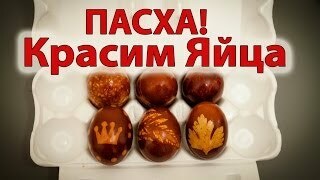 2:18
2:18  4:34
4:34 